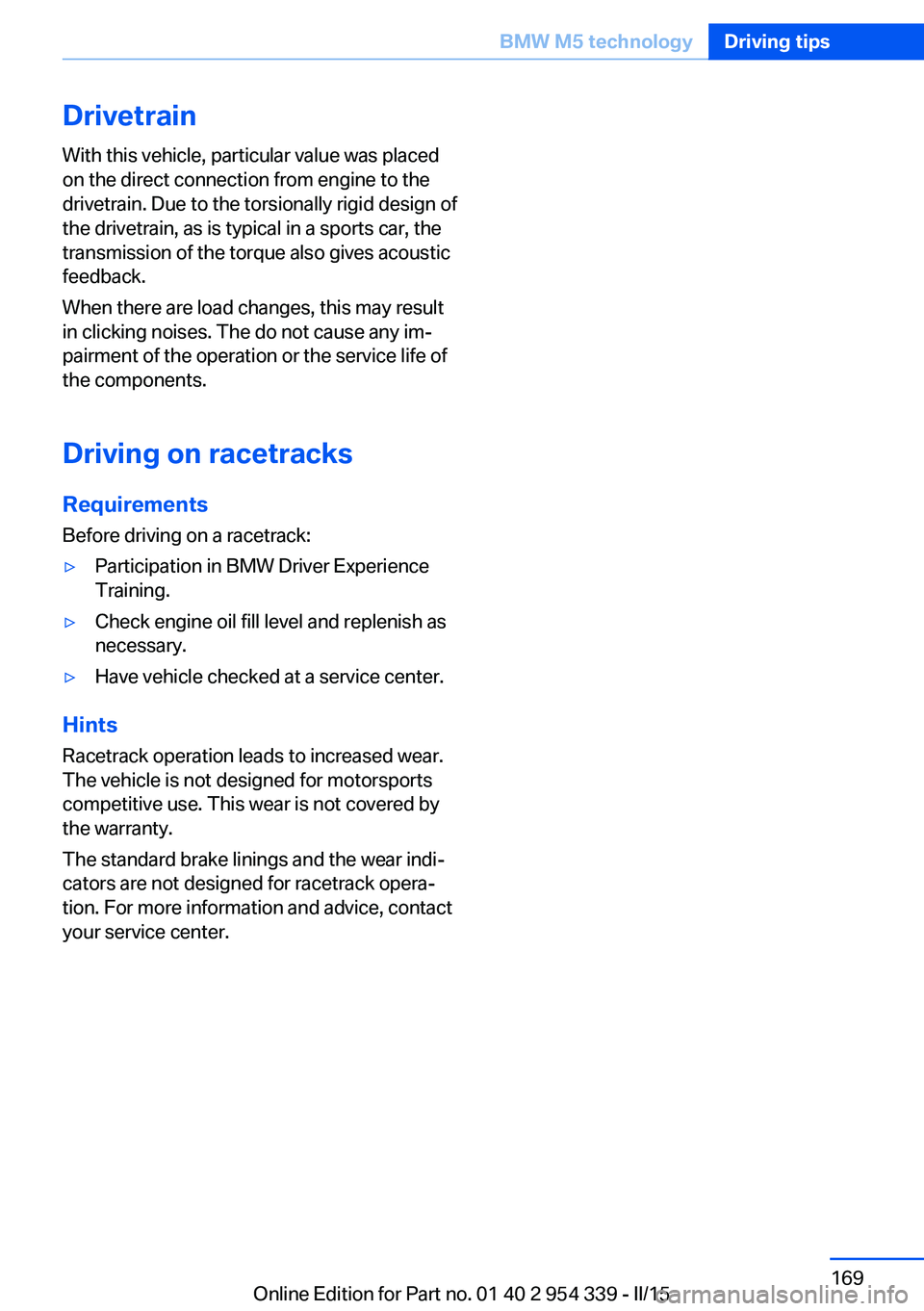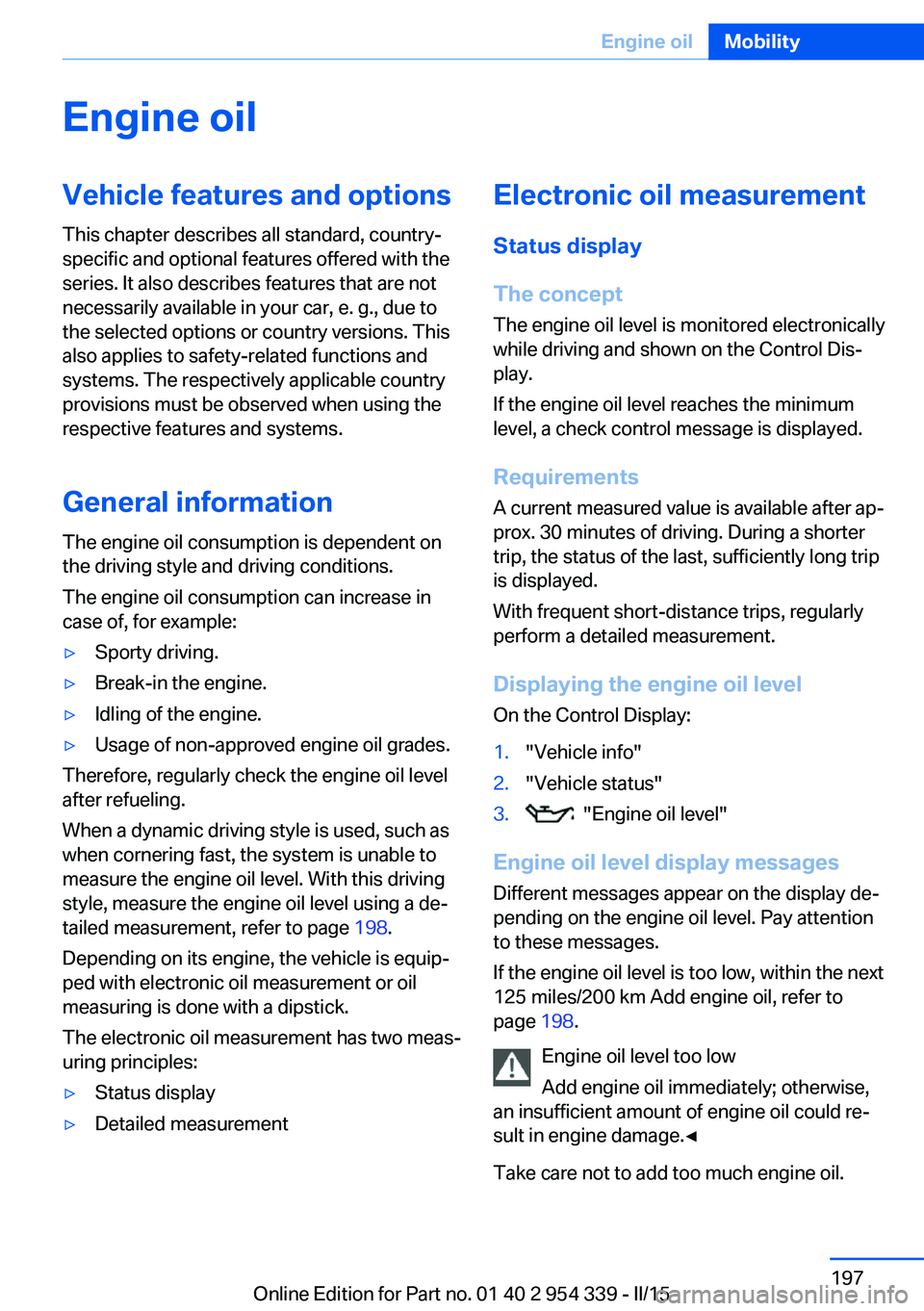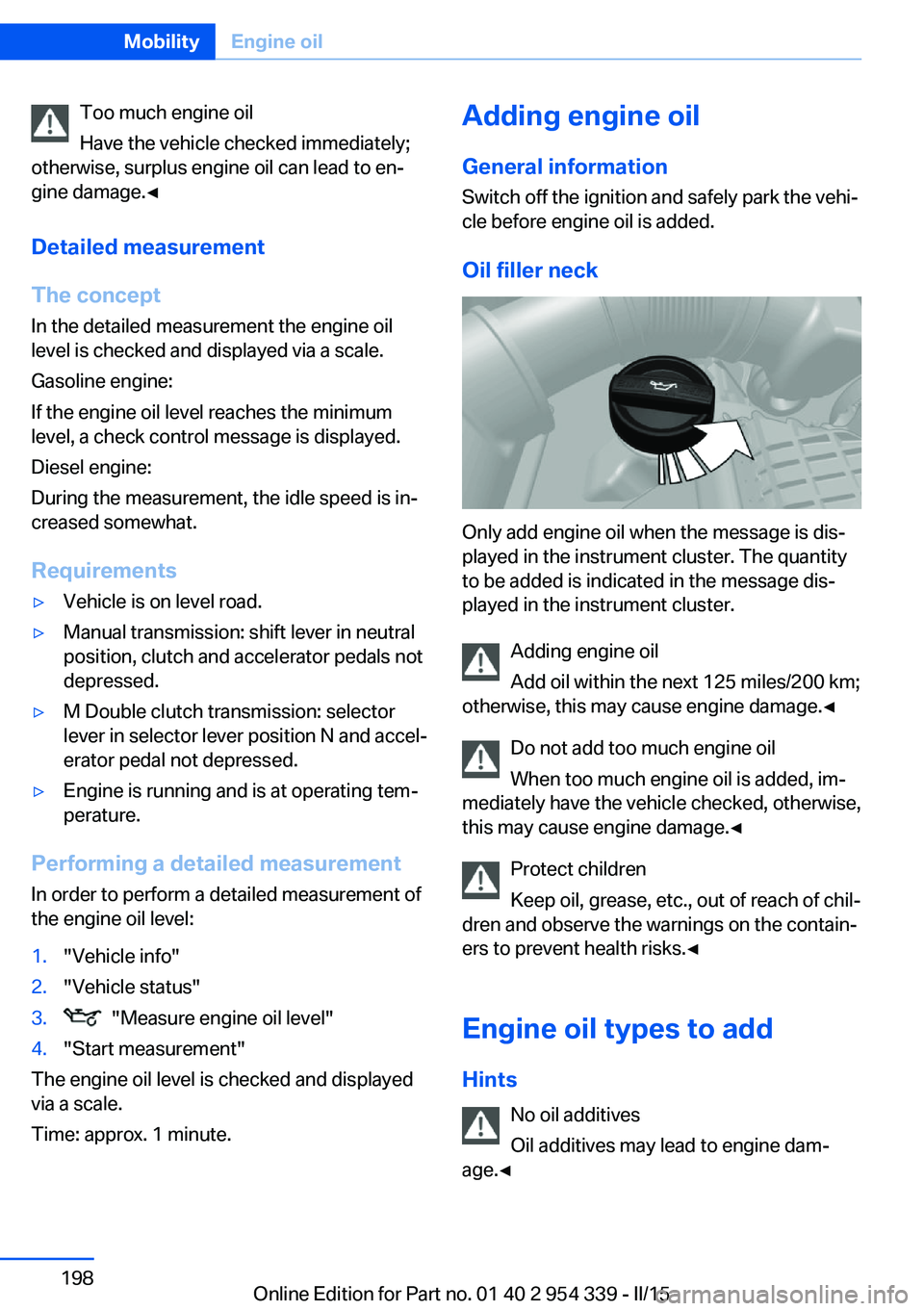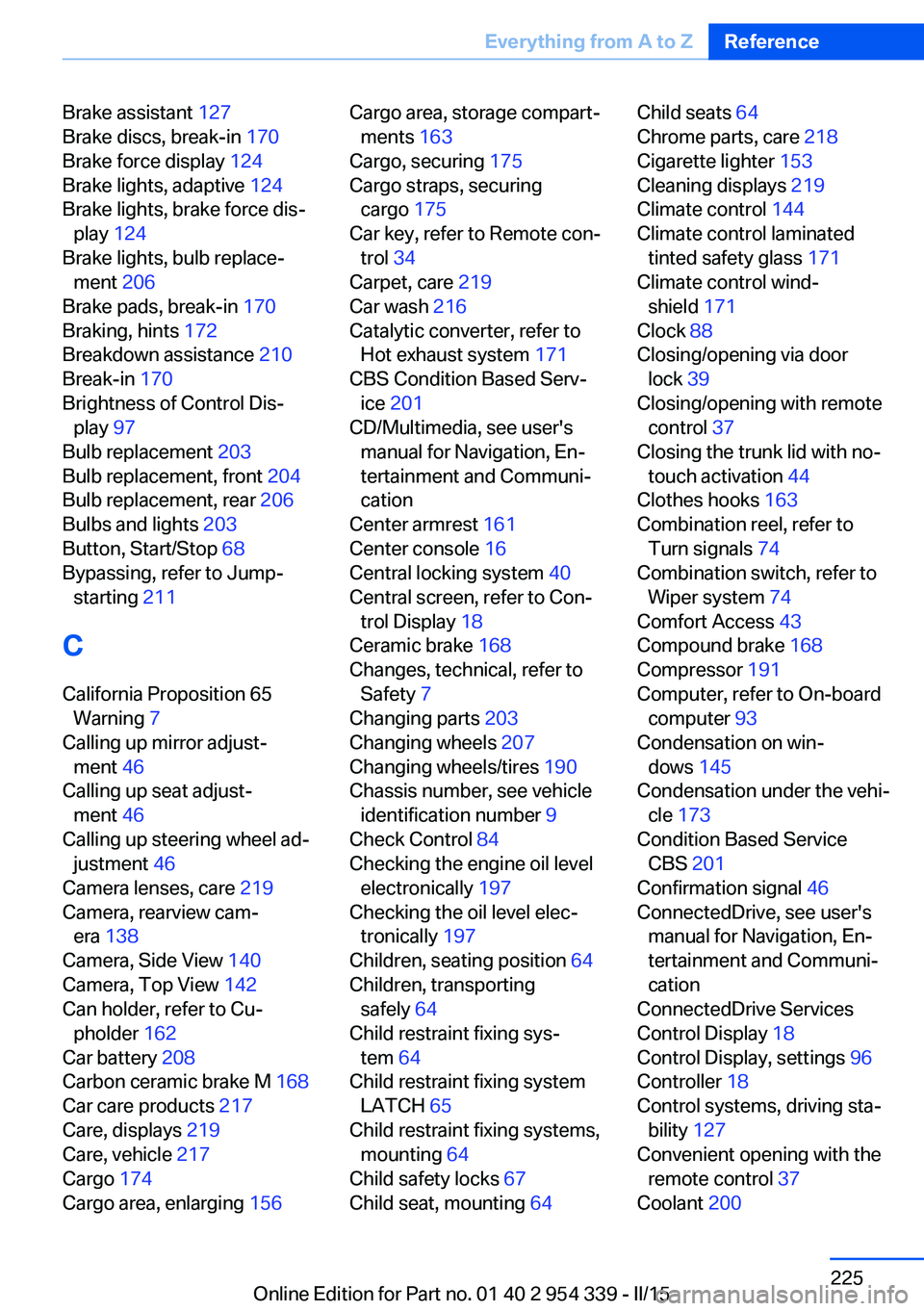2015 BMW M5 SEDAN oil level
[x] Cancel search: oil levelPage 12 of 239

chemicals known to the State of California to
cause cancer and birth defects or other repro‐
ductive harm. Battery posts, terminals and re‐
lated accessories contain lead and lead com‐
pounds. Wash your hands after handling. Used
engine oil contains chemicals that have caused
cancer in laboratory animals. Always protect
your skin by washing thoroughly with soap and
water.
Service and warranty
We recommend that you read this publication
thoroughly. Your vehicle is covered by the fol‐
lowing warranties:▷New Vehicle Limited Warranty.▷Rust Perforation Limited Warranty.▷Federal Emissions System Defect War‐
ranty.▷Federal Emissions Performance Warranty.▷California Emission Control System Lim‐
ited Warranty.
Detailed information about these warranties is
listed in the Service and Warranty Information
Booklet for US models or in the Warranty and
Service Guide Booklet for Canadian models.
Your vehicle has been specifically adapted and
designed to meet the particular operating con‐
ditions and homologation requirements in your
country and continental region in order to de‐
liver the full driving pleasure while the vehicle
is operated under those conditions. If you wish
to operate your vehicle in another country or
region, you may be required to adapt your ve‐
hicle to meet different prevailing operating
conditions and homologation requirements.
You should also be aware of any applicable
warranty limitations or exclusions for such
country or region. In such case, please contact
Customer Relations for further information.
Maintenance
Maintain the vehicle regularly to sustain the
road safety, operational reliability and the New
Vehicle Limited Warranty.
Specifications for required maintenance meas‐
ures:▷BMW Maintenance system▷Service and Warranty Information Booklet
for US models▷Warranty and Service Guide Booklet for
Canadian models
If the vehicle is not maintained according to
these specifications, this could result in seri‐
ous damage to the vehicle. Such damage is
not covered by the BMW New Vehicle Limited
Warranty.
Data memory
Many electronic components on your vehicle
are equipped with data memories that tempo‐
rarily or permanently store technical informa‐
tion about the condition of the vehicle, events
and faults. This technical information generally
records the state of a component, a module, a system or the environment:
▷Operating mode of system components, fill
levels for instance.▷Status messages for the vehicle and from
its individual components, e.g., wheel rota‐
tion speed/vehicle speed, deceleration,
transverse acceleration.▷Malfunctions and faults in important sys‐
tem components, e.g., lights and brakes.▷Responses by the vehicle to special situa‐
tions such as airbag deployment or engag‐
ing the stability control system.▷Ambient conditions, such as temperature.
This data is purely technical in nature and is
used to detect and correct faults and to opti‐
mize vehicle functions. Motion profiles over
routes traveled cannot be created from this
data. When service offerings are used, e.g., re‐
pair services, service processes, warranty
claims, quality assurance, this technical infor‐
mation can be read out from the event and
fault memories by the service personnel, in‐
Seite 8Notes8
Online Edition for Part no. 01 40 2 954 339 - II/15
Page 173 of 239

Drivetrain
With this vehicle, particular value was placed
on the direct connection from engine to the
drivetrain. Due to the torsionally rigid design of
the drivetrain, as is typical in a sports car, the
transmission of the torque also gives acoustic
feedback.
When there are load changes, this may result
in clicking noises. The do not cause any im‐
pairment of the operation or the service life of
the components.
Driving on racetracks
Requirements
Before driving on a racetrack:▷Participation in BMW Driver Experience
Training.▷Check engine oil fill level and replenish as
necessary.▷Have vehicle checked at a service center.
Hints
Racetrack operation leads to increased wear.
The vehicle is not designed for motorsports
competitive use. This wear is not covered by
the warranty.
The standard brake linings and the wear indi‐
cators are not designed for racetrack opera‐
tion. For more information and advice, contact
your service center.
Seite 169BMW M5 technologyDriving tips169
Online Edition for Part no. 01 40 2 954 339 - II/15
Page 195 of 239

Retreaded tires
Possibly substantial variations in the de‐
sign and age of the tire casing structures can
limit service life and have a negative impact on
road safety.◀
Winter tires
Winter tires are recommended for operating on
winter roads.
Although so-called all-season M+S tires pro‐
vide better winter traction than summer tires, they do not provide the same level of perform‐
ance as winter tires.
Maximum speed of winter tires If the maximum speed of the vehicle is higher
than the permissible speed for the winter tires,
then a respective symbol is displayed in your
field of vision. You can obtain this sign from the
tire specialist or from your service center.
Maximum speed for winter tires
Do not exceed the maximum speed for
the respective winter tires; otherwise, tire dam‐
age and accidents can occur.◀
Rotating wheels between axles The manufacturer of your vehicle advises
against switching wheels between the front
and rear axles. This can impair the handling
characteristics.
Rotating the tires is not permissible on vehi‐
cles with different tire sizes or rim sizes on the
front and rear axles.
StorageStore wheels and tires in a cool, dry place with
as little exposure to light as possible.
Always protect tires against all contact with oil,
grease and fuels.
Do not exceed the maximum tire inflation pres‐
sure indicated on the side wall of the tire.Mobility System
The concept
With the Mobility System, minor tire damage
can be sealed quickly to enable continued
travel. To accomplish this, sealant is pumped
into the tires, which seals the damage from the
inside.
The compressor can be used to check the tire
inflation pressure.
Hints▷Follow the instructions on using the Mobi‐
lity System found on the compressor and
sealant container.▷Use of the Mobility System may be ineffec‐
tive if the tire puncture measures approx.
1/8 in/4 mm or more.▷Contact the nearest service center if the
tire cannot be made drivable.▷If possible, do not remove foreign bodies
that have penetrated the tire.▷Pull the speed limit sticker off the sealant
container and apply it to the steering
wheel.▷The use of a sealant can damage the TPM
wheel electronics. In this case, have the
electronics checked at the next opportu‐
nity and have them replaced if needed.
Enclosed areas
Do not let the engine run in enclosed
areas, since breathing in exhaust fumes may
lead to loss of consciousness and death. The
exhaust gases contain carbon monoxide, an
odorless and colorless but highly toxic gas.◀
Storage The Mobility System is located under the
cargo floor panel.
Seite 191Wheels and tiresMobility191
Online Edition for Part no. 01 40 2 954 339 - II/15
Page 201 of 239

Engine oilVehicle features and options
This chapter describes all standard, country-
specific and optional features offered with the
series. It also describes features that are not
necessarily available in your car, e. g., due to
the selected options or country versions. This
also applies to safety-related functions and
systems. The respectively applicable country
provisions must be observed when using the
respective features and systems.
General information The engine oil consumption is dependent on
the driving style and driving conditions.
The engine oil consumption can increase in
case of, for example:▷Sporty driving.▷Break-in the engine.▷Idling of the engine.▷Usage of non-approved engine oil grades.
Therefore, regularly check the engine oil level
after refueling.
When a dynamic driving style is used, such as
when cornering fast, the system is unable to
measure the engine oil level. With this driving
style, measure the engine oil level using a de‐
tailed measurement, refer to page 198.
Depending on its engine, the vehicle is equip‐
ped with electronic oil measurement or oil
measuring is done with a dipstick.
The electronic oil measurement has two meas‐
uring principles:
▷Status display▷Detailed measurementElectronic oil measurement
Status display
The concept
The engine oil level is monitored electronically
while driving and shown on the Control Dis‐
play.
If the engine oil level reaches the minimum
level, a check control message is displayed.
Requirements
A current measured value is available after ap‐
prox. 30 minutes of driving. During a shorter
trip, the status of the last, sufficiently long trip
is displayed.
With frequent short-distance trips, regularly
perform a detailed measurement.
Displaying the engine oil level
On the Control Display:1."Vehicle info"2."Vehicle status"3. "Engine oil level"
Engine oil level display messages
Different messages appear on the display de‐
pending on the engine oil level. Pay attention
to these messages.
If the engine oil level is too low, within the next
125 miles/200 km Add engine oil, refer to
page 198.
Engine oil level too low
Add engine oil immediately; otherwise,
an insufficient amount of engine oil could re‐
sult in engine damage.◀
Take care not to add too much engine oil.
Seite 197Engine oilMobility197
Online Edition for Part no. 01 40 2 954 339 - II/15
Page 202 of 239

Too much engine oil
Have the vehicle checked immediately;
otherwise, surplus engine oil can lead to en‐
gine damage.◀
Detailed measurement
The concept In the detailed measurement the engine oil
level is checked and displayed via a scale.
Gasoline engine:
If the engine oil level reaches the minimum
level, a check control message is displayed.
Diesel engine:
During the measurement, the idle speed is in‐
creased somewhat.
Requirements▷Vehicle is on level road.▷Manual transmission: shift lever in neutral
position, clutch and accelerator pedals not
depressed.▷M Double clutch transmission: selector
lever in selector lever position N and accel‐
erator pedal not depressed.▷Engine is running and is at operating tem‐
perature.
Performing a detailed measurement
In order to perform a detailed measurement of
the engine oil level:
1."Vehicle info"2."Vehicle status"3. "Measure engine oil level"4."Start measurement"
The engine oil level is checked and displayed
via a scale.
Time: approx. 1 minute.
Adding engine oil
General information
Switch off the ignition and safely park the vehi‐
cle before engine oil is added.
Oil filler neck
Only add engine oil when the message is dis‐
played in the instrument cluster. The quantity
to be added is indicated in the message dis‐
played in the instrument cluster.
Adding engine oil
Add oil within the next 125 miles/200 km;
otherwise, this may cause engine damage.◀
Do not add too much engine oil
When too much engine oil is added, im‐
mediately have the vehicle checked, otherwise,
this may cause engine damage.◀
Protect children
Keep oil, grease, etc., out of reach of chil‐
dren and observe the warnings on the contain‐
ers to prevent health risks.◀
Engine oil types to add Hints No oil additives
Oil additives may lead to engine dam‐
age.◀
Seite 198MobilityEngine oil198
Online Edition for Part no. 01 40 2 954 339 - II/15
Page 229 of 239

Brake assistant 127
Brake discs, break-in 170
Brake force display 124
Brake lights, adaptive 124
Brake lights, brake force dis‐ play 124
Brake lights, bulb replace‐ ment 206
Brake pads, break-in 170
Braking, hints 172
Breakdown assistance 210
Break-in 170
Brightness of Control Dis‐ play 97
Bulb replacement 203
Bulb replacement, front 204
Bulb replacement, rear 206
Bulbs and lights 203
Button, Start/Stop 68
Bypassing, refer to Jump- starting 211
C
California Proposition 65 Warning 7
Calling up mirror adjust‐ ment 46
Calling up seat adjust‐ ment 46
Calling up steering wheel ad‐ justment 46
Camera lenses, care 219
Camera, rearview cam‐ era 138
Camera, Side View 140
Camera, Top View 142
Can holder, refer to Cu‐ pholder 162
Car battery 208
Carbon ceramic brake M 168
Car care products 217
Care, displays 219
Care, vehicle 217
Cargo 174
Cargo area, enlarging 156 Cargo area, storage compart‐
ments 163
Cargo, securing 175
Cargo straps, securing cargo 175
Car key, refer to Remote con‐ trol 34
Carpet, care 219
Car wash 216
Catalytic converter, refer to Hot exhaust system 171
CBS Condition Based Serv‐ ice 201
CD/Multimedia, see user's manual for Navigation, En‐
tertainment and Communi‐
cation
Center armrest 161
Center console 16
Central locking system 40
Central screen, refer to Con‐ trol Display 18
Ceramic brake 168
Changes, technical, refer to Safety 7
Changing parts 203
Changing wheels 207
Changing wheels/tires 190
Chassis number, see vehicle identification number 9
Check Control 84
Checking the engine oil level electronically 197
Checking the oil level elec‐ tronically 197
Children, seating position 64
Children, transporting safely 64
Child restraint fixing sys‐ tem 64
Child restraint fixing system LATCH 65
Child restraint fixing systems, mounting 64
Child safety locks 67
Child seat, mounting 64 Child seats 64
Chrome parts, care 218
Cigarette lighter 153
Cleaning displays 219
Climate control 144
Climate control laminated tinted safety glass 171
Climate control wind‐ shield 171
Clock 88
Closing/opening via door lock 39
Closing/opening with remote control 37
Closing the trunk lid with no- touch activation 44
Clothes hooks 163
Combination reel, refer to Turn signals 74
Combination switch, refer to Wiper system 74
Comfort Access 43
Compound brake 168
Compressor 191
Computer, refer to On-board computer 93
Condensation on win‐ dows 145
Condensation under the vehi‐ cle 173
Condition Based Service CBS 201
Confirmation signal 46
ConnectedDrive, see user's manual for Navigation, En‐
tertainment and Communi‐
cation
ConnectedDrive Services
Control Display 18
Control Display, settings 96
Controller 18
Control systems, driving sta‐ bility 127
Convenient opening with the remote control 37
Coolant 200 Seite 225Everything from A to ZReference225
Online Edition for Part no. 01 40 2 954 339 - II/15
Page 230 of 239

Coolant level 200
Coolant temperature 88
Cooling function 146
Cooling, maximum 146
Cooling system 200
Cornering light 101
Corrosion on brake discs 173
Cosmetic mirror 153
Courtesy lamps during un‐ locking 37
Courtesy lamps with the vehi‐ cle locked 38
Cruise control 133
Cruising range 89
Cupholder 162
Current fuel consumption 89
D
Damage, tires 189
Damping control 131
Damping control, dy‐ namic 131
Data, technical 222
Date 88
Daytime running lights 101
Defrosting, refer to Windows, defrosting 145
Dehumidifying, air 146
Deleting personal data 24
Deletion of personal data 24
Destination distance 94
Differential lock 131
Digital clock 88
Digital speed 88
Digital tachometer 88
Dimensions 222
Dimmable exterior mirrors 61
Dimmable interior rearview mirror 62
Direction indicator, refer to Turn signals 74
Display EfficientDynamics 90
Display, electronic, instru‐ ment cluster 83
Display in windshield 97 Display lighting, refer to In‐
strument lighting 103
Displays, cleaning 219
Disposal, coolant 200
Disposal, vehicle battery 208
Distance control, refer to PDC 135
Distance to destination 94
Divided screen view, split screen 23
Door lock 39
Door lock, refer to Remote control 34
Doors, Automatic Soft Clos‐ ing 40
Double-clutch transmis‐ sion 77
Drivelogic 79
Drive mode 78
Drive-off assistant 127
Drive-off assistant, refer to DSC 129
Driver assistance, refer to In‐ telligent Safety 112
Driving Assistant, refer to In‐ telligent Safety 112
Driving Dynamics Control 81
Driving instructions, break- in 170
Driving notes, general 171
Driving on racetracks 169
Driving program, refer to Drivelogic 79
Driving stability control sys‐ tems 127
Driving tips 171
DSC Dynamic Stability Con‐ trol 129
Dynamic Damping Con‐ trol 131
Dynamic driving systems 90
Dynamic driving, system states 90
Dynamic Stability Control DSC 129 E
EfficientDynamics 90
Electronic displays, instru‐ ment cluster 83
Electronic oil measure‐ ment 197
Electronic Stability Program ESP, refer to DSC 129
Emergency detection, remote control 35
Emergency release, fuel filler flap 182
Emergency Request 210
Emergency start function, en‐ gine start 35
Emergency unlocking, trunk lid 43
Energy Control 89
Energy recovery 89
Engine, automatic Start/Stop function 70
Engine, automatic switch- off 70
Engine compartment 195
Engine compartment, work‐ ing in 195
Engine coolant 200
Engine oil 197
Engine oil, adding 198
Engine oil additives 198
Engine oil change 199
Engine oil filler neck 198
Engine oil temperature 87
Engine oil types, alterna‐ tive 199
Engine oil types, ap‐ proved 199
Engine start during malfunc‐ tion 35
Engine start, jump-start‐ ing 211
Engine start, refer to Starting the engine 69
Engine stop 69
Engine temperature 87 Seite 226ReferenceEverything from A to Z226
Online Edition for Part no. 01 40 2 954 339 - II/15